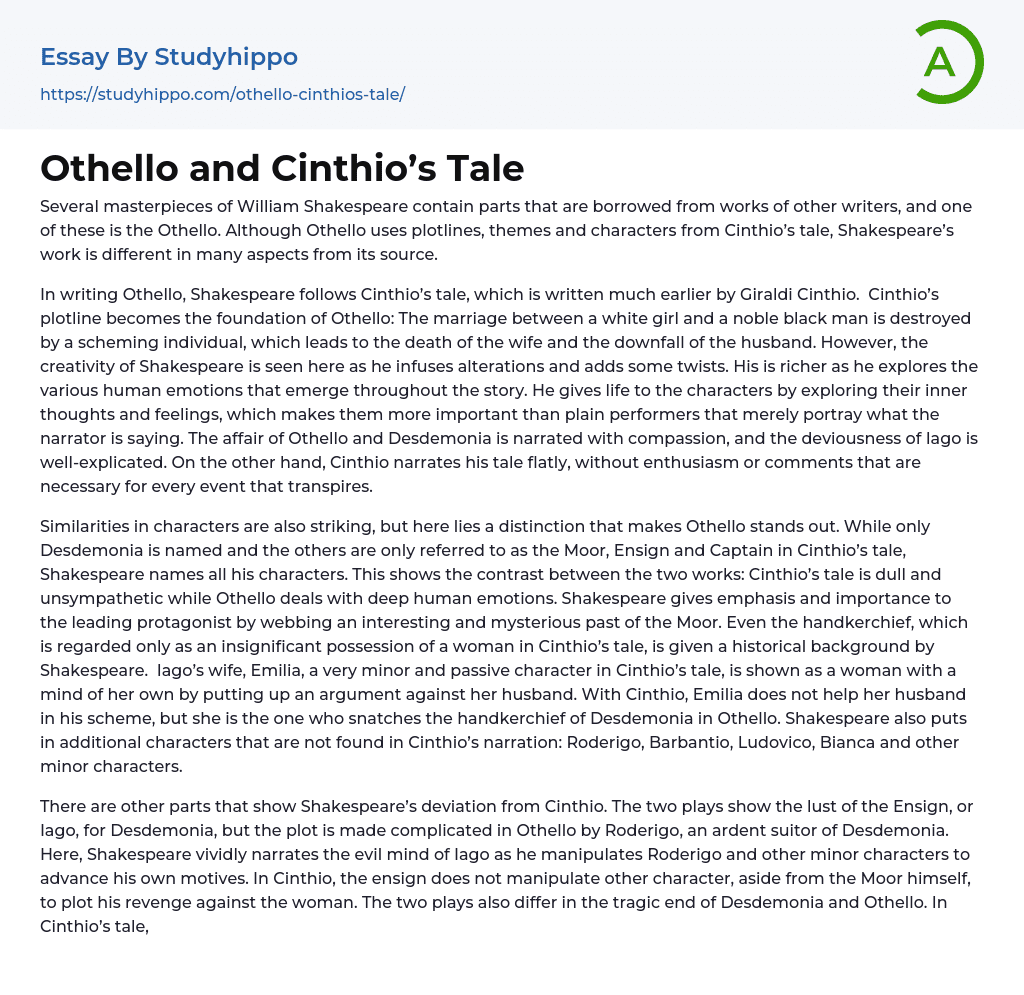Several masterpieces of William Shakespeare contain parts that are borrowed from works of other writers, and one of these is the Othello. Although Othello uses plotlines, themes and characters from Cinthio’s tale, Shakespeare’s work is different in many aspects from its source.
In writing Othello, Shakespeare follows Cinthio’s tale, which is written much earlier by Giraldi Cinthio. Cinthio’s plotline becomes the foundation of Othello: The marriage between a white girl and a noble black man is destroyed by a scheming individual, which leads to the death of the wife and the downfall of the husband. However, the creativity of Shakespeare is seen here as he infuses alterations and adds some twists. His is richer as he explores the various human emotions that emerge throughout the story. He gives life to the characters by exploring their inner thoughts and feelings,
...which makes them more important than plain performers that merely portray what the narrator is saying. The affair of Othello and Desdemonia is narrated with compassion, and the deviousness of Iago is well-explicated. On the other hand, Cinthio narrates his tale flatly, without enthusiasm or comments that are necessary for every event that transpires.
Similarities in characters are also striking, but here lies a distinction that makes Othello stands out. While only Desdemonia is named and the others are only referred to as the Moor, Ensign and Captain in Cinthio’s tale, Shakespeare names all his characters. This shows the contrast between the two works: Cinthio’s tale is dull and unsympathetic while Othello deals with deep human emotions. Shakespeare gives emphasis and importance to the leading protagonist by webbing an interesting and mysterious past of the Moor. Even th
handkerchief, which is regarded only as an insignificant possession of a woman in Cinthio’s tale, is given a historical background by Shakespeare. Iago’s wife, Emilia, a very minor and passive character in Cinthio’s tale, is shown as a woman with a mind of her own by putting up an argument against her husband. With Cinthio, Emilia does not help her husband in his scheme, but she is the one who snatches the handkerchief of Desdemonia in Othello. Shakespeare also puts in additional characters that are not found in Cinthio’s narration: Roderigo, Barbantio, Ludovico, Bianca and other minor characters.
There are other parts that show Shakespeare’s deviation from Cinthio. The two plays show the lust of the Ensign, or Iago, for Desdemonia, but the plot is made complicated in Othello by Roderigo, an ardent suitor of Desdemonia. Here, Shakespeare vividly narrates the evil mind of Iago as he manipulates Roderigo and other minor characters to advance his own motives. In Cinthio, the ensign does not manipulate other character, aside from the Moor himself, to plot his revenge against the woman. The two plays also differ in the tragic end of Desdemonia and Othello. In Cinthio’s tale, Othello orders the Ensign to kill Desdemonia by hitting her with stocking filled with sand. Othello is put in prison, after the Ensign witnesses against him, and eventually killed by the woman’s relatives. In Shakespeare’s version, Othello himself kills Desdemonia. After learning the truth, Othello commits suicide.
Shakespeare’ motive for writing Othello is perhaps to emphasize the savagery of the black people during that time. The play shows the moralistic point of view that a white woman marrying a black man is
not acceptable. This notion is justified as the play ends with Othello turning savage by murdering his wife and committing suicide. On the other hand, Shakespeare may have written the play in order to show to all that the blacks are only humans that only turn savage because of the influence of their surroundings. Shakespeare elevates the image of the blacks as Othello is portrayed as a noble General of a fleet and a tragic hero that falls victim of the society. Although he commits a despicable act, he regains his nobility at the end by admitting his fault and taking his own life.
Work Cited:
Shakespeare, William. Othello. København: Teater Sthyr &Kjær, Huset i Magstræde, 2001.
- Othello Jealousy essays
- A Doll's House essays
- A Midsummer Night's Dream essays
- A raisin in the sun essays
- A Streetcar Named Desire essays
- An Inspector Calls essays
- Death of a salesman essays
- Everyman essays
- Fences essays
- Hamlet essays
- Hedda Gabler essays
- Iago essays
- King Lear essays
- Macbeth essays
- Much ado about nothing essays
- Oedipus Rex essays
- Oedipus The King essays
- Othello essays
- Pygmalion essays
- Romeo And Juliet essays
- Tartuffe essays
- The glass menagerie essays
- The Importance of Being Earnest essays
- The Merchant Of Venice essays
- The Taming of The Shrew essays
- Twelfth Night essays
- Waiting For Godot essays
- Aldous Huxley essays
- Alice Walker essays
- Amy tan essays
- Anne Bradstreet essays
- Anton Chekhov essays
- Arthur Miller essays
- Augustine essays
- Bertolt Brecht essays
- Booker T Washington essays
- Carol ann duffy essays
- Charles Dickens essays
- Charlotte Perkins Gilman essays
- Chinua Achebe essays
- Christina Rossetti essays
- Consider The Lobster essays
- Edgar Allan Poe essays
- Elizabeth Bishop essays
- Emily Dickinson essays
- Ernest Hemingway essays
- F. Scott Fitzgerald essays
- George Orwell essays
- Harper Lee essays
- Homer essays




